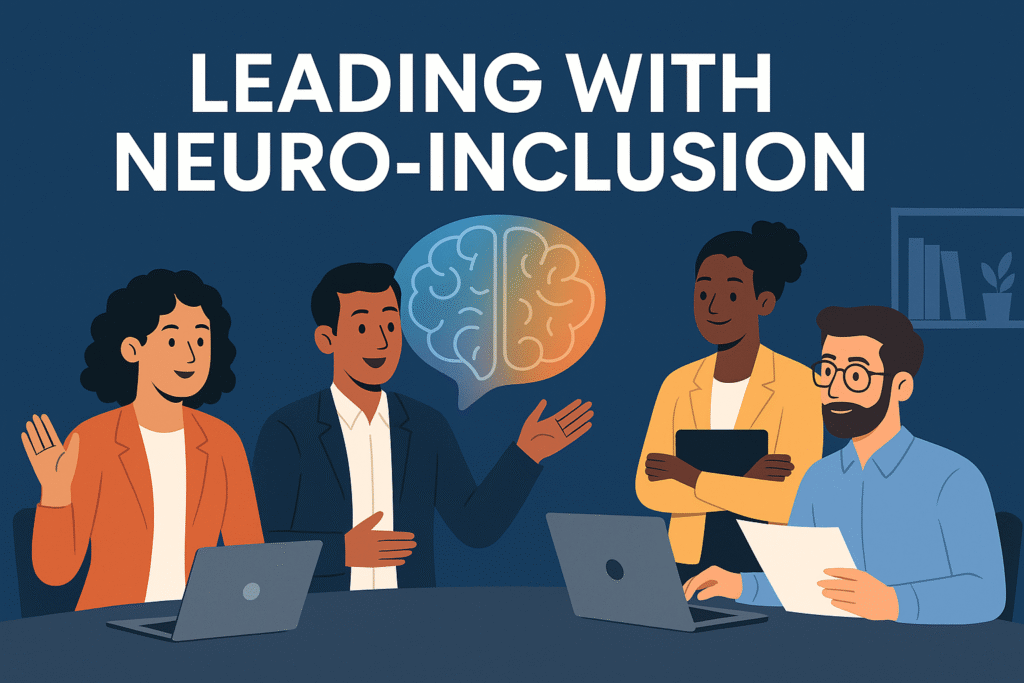The workplace is evolving rapidly—and so is the definition of great leadership. In a world where adaptability, empathy, and innovation define success, leaders must learn to manage not just diverse teams, but diverse minds.
Neurodiversity—the natural variation in how brains think and process information—is one of the most important yet overlooked elements of modern leadership. As organizations embrace more inclusive practices, understanding how to lead neurodivergent employees is no longer optional—it’s essential.
Through Elevate Up’s Neuro-Inclusive Leadership Workshop, leaders gain the skills, insight, and confidence to support every kind of thinker on their teams. Below are the essential lessons and takeaways that every organization can apply to strengthen inclusion and performance.
1. Neuro-Inclusion Is a Strategic Advantage
Inclusion is often framed as a moral goal—but in today’s competitive market, it’s a strategic advantage. Teams that embrace cognitive diversity outperform others in problem-solving, innovation, and decision-making.
Neuro-inclusive leadership means recognizing that different thinking styles can complement one another. A dyslexic employee might excel in visual strategy, while an autistic colleague may bring structure and precision to planning. Together, they form a team with greater creative balance and foresight.
When leaders understand and leverage these differences, performance becomes both more human and more effective.
2. From Reactive to Proactive Leadership
Traditional management waits for employees to raise issues or request accommodations. Neuro-inclusive leadership takes the opposite approach—it anticipates needs and builds flexibility from the start.
This includes offering multiple communication formats, allowing flexible scheduling, and prioritizing clarity over assumption. The result? Employees feel safe to contribute their best work without constantly explaining or justifying their needs.
Leadership training in neuro-inclusion helps shift the mindset from “How do I fix this?” to “How do I design this better for everyone?”
3. Psychological Safety Is the Foundation of Inclusion
Neurodivergent employees often mask their true behaviors to fit in—a process that leads to stress, exhaustion, and disengagement. The antidote is psychological safety: a culture where employees can express ideas or concerns without fear of being judged or misunderstood.
Leaders who model openness and vulnerability—by asking questions, admitting uncertainty, and valuing honesty—set the tone for authentic collaboration. When safety replaces stigma, creativity flourishes.
4. Empowering Middle Managers to Lead Inclusively
Policies alone can’t make a workplace inclusive—people can. Middle managers, who interact most directly with employees, are the true gatekeepers of inclusion.
Training helps them master clear communication, structured delegation, and empathy-driven feedback. Managers learn to focus on individual strengths and adjust workflows to reduce friction. This not only supports neurodivergent team members but improves overall team efficiency.
When managers lead with understanding, inclusion becomes part of everyday culture, not an isolated initiative.
5. Redefining What Leadership Looks Like
Many traditional leadership models prioritize traits like extroversion, charisma, and multitasking. But neuro-inclusive leadership expands that definition. Analytical thinkers, reflective communicators, and specialists in deep-focus work bring different—but equally valuable—forms of leadership.
By recognizing these qualities, organizations open pathways for diverse individuals to thrive in leadership roles. Diversity at the top fosters better decision-making and builds trust throughout the company.
6. Listening Before Leading
Leaders don’t need to be experts in neurodiversity—they just need to be curious and compassionate listeners. Asking questions such as “How can I support you best?” or “What helps you focus?” fosters collaboration and reduces assumptions.
Active listening transforms leadership from authority into partnership. It empowers employees to voice what they need while helping managers tailor their approach in real time.
7. Inclusion as a Continuous Practice
Neuro-inclusion isn’t a one-time effort—it’s an evolving practice that deepens with consistency. Organizations that track progress, gather feedback, and revisit their strategies build cultures that remain adaptive and resilient.
When inclusion becomes embedded in leadership development, it stops being an initiative and starts being an identity.
Leadership That Includes Every Mind
The leaders of the future will be those who understand how to unlock the full potential of their teams—by embracing differences, not overlooking them. Neuro-inclusive leadership is not about changing people; it’s about changing systems so everyone can contribute their best.
Elevate Up partners with organizations to create evidence-based, actionable neuro-inclusion programs that equip leaders to guide diverse teams with confidence. Our mission is simple: to elevate leadership through understanding, empathy, and inclusion—so every mind has the opportunity to lead and succeed.







